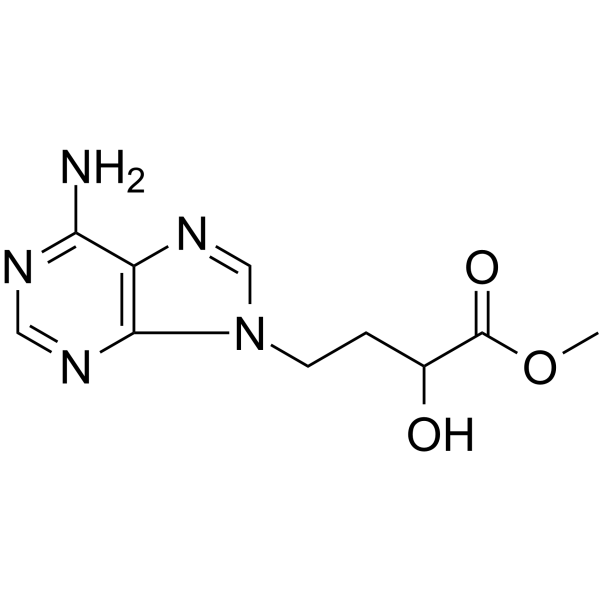All AbMole products are for research use only, cannot be used for human consumption.

For this product's availability, delivery time and price, please email [email protected] directly or click the "Inquiry Now" button below.
DZ2002 is a potent and reversible S-Adenosyl-L-homocysteine Hydrolase(SAHH; AdoHcy Hydrolase) inhibitor with Ki of 17.9 nM. IC50 value: 17.9 nM(Ki) Target: AdoHcy Hydrolase inhibitor in vitro: The cytotoxicity of DZ2002 is significantly less than DHCaA with an IC50 of 100 to 600 μM compared with 6 to 14 μM and shows very little cytotoxicity up to 100 μM. DZ2002 had little effects on lymphocyte proliferation (0.1 μM = 150,604 ± 13,862, 1 μM = 159,894 ± 11,152, and 10 μM = 136,157 ± 21,943 cpm) versus untreated Con A-stimulated cells (168,725 ± 8025 cpm). Similarly, little effect was seen in regards to IL-2 production from DZ2002-treated cells (0.1 μM = 1,838 ± 88, 1 μM = 1,793 ± 58, and 10 μM = 1,731 ± 36 pg/ml) versus untreated Con A-stimulated cells (1,806 ± 43 pg/ml). Although DZ2002 had little effect when T cells were stimulated with Con A, DZ2002 suppressed the MLR by 24.5, 42.3, and 46.0% at dosages of 0.1, 1, and 10 μM, respectively. DZ2002 (500 μmol/L) significantly suppressed TLR agonists-stimulated up-regulation in IL-6, IL-12p40, TNF-α, and IgG and IgM secretion as well as in HLA-DR and CD40 expression of dendritic cells among human PBMCs in vitro. DZ2002 (100 μmol/L) also significantly suppressed TLR agonists-stimulated up-regulation in IL-6 and IL-23p19 production in murine BMDCs, and prevented Th17 differentiation and suppressed IL-17 secretion by the T cells in a BMDC-T cell co-culture system. in vivo: As compared with controls, consecutive 7-day i.p. injections of DZ2002 inhibited hemolysis by 24.5 and 18.4% at doses of 0.08 and 2 mg/kg, respectively, thus decreasing anti-SRBC antibody production in vivo. Male C57BL/6 mice immunized with ovalbumin (OVA) were treated with DZ2002 (1, 5, and 25 mg/kg/day) after which lymphocyte proliferation, cytokine production, and IgG responses to OVA were monitored. Administration of DZ2002 dose dependently suppressed OVA-specific lymphocyte proliferation and anti-OVA IgG production compared with controls. Treatment of the mice with DZ2002 significantly attenuated the progression of glomerulonephritis and improved the overall health. In ex vivo studies, treatment of the mice with DZ2002 suppressed the development of pathogenic Th17 cells, significantly decreased IL-17, TGF-β, IL-6, and IL-23p19 production and impeded activation of the STAT3 protein and JNK/NF-κB signaling in splenocytes.
| Molecular Weight | 251.24 |
| CAS Number | 33231-14-0 |
| Solubility (25°C) | DMSO ≥ 61 mg/mL |
| Storage |
Powder -20°C 3 years ; 4°C 2 years In solvent -80°C 6 months ; -20°C 1 month |
| Related Products |
|---|
| 2-Deoxy-2-fluoro-D-glucose
2-Deoxy-2-fluoro-D-glucose is a radiolabeled glucose analog, which is commonly used in medical imaging techniques such as positron emission tomography (PET) scans. |
| 2-Bromo-4-chlorophenylacetic acid
2-Bromo-4-chlorophenylacetic acid is a biochemical reagent. |
| CPN-351 TFA
CPN-351 TFA is a selective pentapeptide antagonist of human NMUR1 with a pA2 of 7.35. CPN-351 TFA can be used for the research of inflammation. |
| 5-Phenyluracil
5-Phenyluracil is a pyrimidine derivative, a class of heterocyclic aromatic organic compounds crucial in biochemistry. It serves as a synthetic nucleoside analogue, meaning it mimics the structure of naturally occurring nucleosides like uridine. This structural similarity allows it to participate in biochemical reactions, often interfering with normal cellular processes, making it a valuable tool in studying nucleic acid metabolism and developing antiviral and anticancer agents. |
| 7-Deoxyloganin
7-Deoxyloganin is a biosynthetic precursor of Loganin. 7-Deoxyloganin undergoes hydroxylation catalyzed by 7-deoxyloganin 7-hydroxylase, a cytochrome P450-dependent monooxygenase, to produce Loganin. |
All AbMole products are for research use only, cannot be used for human consumption or veterinary use. We do not provide products or services to individuals. Please comply with the intended use and do not use AbMole products for any other purpose.


Products are for research use only. Not for human use. We do not sell to patients.
© Copyright 2010-2024 AbMole BioScience. All Rights Reserved.
